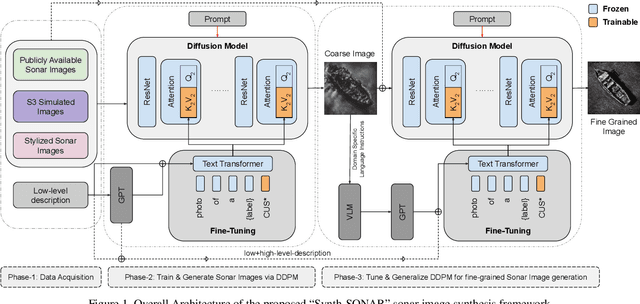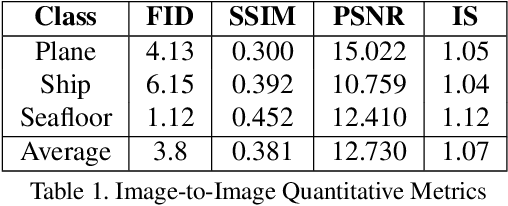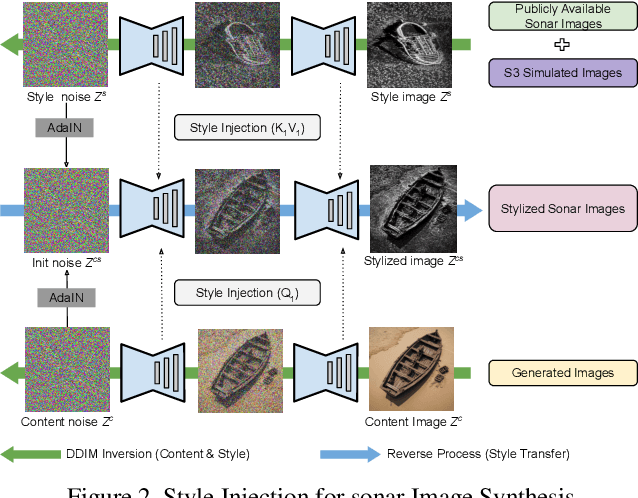Purushothaman Natarajan
Synth-SONAR: Sonar Image Synthesis with Enhanced Diversity and Realism via Dual Diffusion Models and GPT Prompting
Oct 11, 2024



Abstract:Sonar image synthesis is crucial for advancing applications in underwater exploration, marine biology, and defence. Traditional methods often rely on extensive and costly data collection using sonar sensors, jeopardizing data quality and diversity. To overcome these limitations, this study proposes a new sonar image synthesis framework, Synth-SONAR leveraging diffusion models and GPT prompting. The key novelties of Synth-SONAR are threefold: First, by integrating Generative AI-based style injection techniques along with publicly available real/simulated data, thereby producing one of the largest sonar data corpus for sonar research. Second, a dual text-conditioning sonar diffusion model hierarchy synthesizes coarse and fine-grained sonar images with enhanced quality and diversity. Third, high-level (coarse) and low-level (detailed) text-based sonar generation methods leverage advanced semantic information available in visual language models (VLMs) and GPT-prompting. During inference, the method generates diverse and realistic sonar images from textual prompts, bridging the gap between textual descriptions and sonar image generation. This marks the application of GPT-prompting in sonar imagery for the first time, to the best of our knowledge. Synth-SONAR achieves state-of-the-art results in producing high-quality synthetic sonar datasets, significantly enhancing their diversity and realism.
VALE: A Multimodal Visual and Language Explanation Framework for Image Classifiers using eXplainable AI and Language Models
Aug 23, 2024Abstract:Deep Neural Networks (DNNs) have revolutionized various fields by enabling task automation and reducing human error. However, their internal workings and decision-making processes remain obscure due to their black box nature. Consequently, the lack of interpretability limits the application of these models in high-risk scenarios. To address this issue, the emerging field of eXplainable Artificial Intelligence (XAI) aims to explain and interpret the inner workings of DNNs. Despite advancements, XAI faces challenges such as the semantic gap between machine and human understanding, the trade-off between interpretability and performance, and the need for context-specific explanations. To overcome these limitations, we propose a novel multimodal framework named VALE Visual and Language Explanation. VALE integrates explainable AI techniques with advanced language models to provide comprehensive explanations. This framework utilizes visual explanations from XAI tools, an advanced zero-shot image segmentation model, and a visual language model to generate corresponding textual explanations. By combining visual and textual explanations, VALE bridges the semantic gap between machine outputs and human interpretation, delivering results that are more comprehensible to users. In this paper, we conduct a pilot study of the VALE framework for image classification tasks. Specifically, Shapley Additive Explanations (SHAP) are used to identify the most influential regions in classified images. The object of interest is then extracted using the Segment Anything Model (SAM), and explanations are generated using state-of-the-art pre-trained Vision-Language Models (VLMs). Extensive experimental studies are performed on two datasets: the ImageNet dataset and a custom underwater SONAR image dataset, demonstrating VALEs real-world applicability in underwater image classification.
Underwater SONAR Image Classification and Analysis using LIME-based Explainable Artificial Intelligence
Aug 23, 2024Abstract:Deep learning techniques have revolutionized image classification by mimicking human cognition and automating complex decision-making processes. However, the deployment of AI systems in the wild, especially in high-security domains such as defence, is curbed by the lack of explainability of the model. To this end, eXplainable AI (XAI) is an emerging area of research that is intended to explore the unexplained hidden black box nature of deep neural networks. This paper explores the application of the eXplainable Artificial Intelligence (XAI) tool to interpret the underwater image classification results, one of the first works in the domain to the best of our knowledge. Our study delves into the realm of SONAR image classification using a custom dataset derived from diverse sources, including the Seabed Objects KLSG dataset, the camera SONAR dataset, the mine SONAR images dataset, and the SCTD dataset. An extensive analysis of transfer learning techniques for image classification using benchmark Convolutional Neural Network (CNN) architectures such as VGG16, ResNet50, InceptionV3, DenseNet121, etc. is carried out. On top of this classification model, a post-hoc XAI technique, viz. Local Interpretable Model-Agnostic Explanations (LIME) are incorporated to provide transparent justifications for the model's decisions by perturbing input data locally to see how predictions change. Furthermore, Submodular Picks LIME (SP-LIME) a version of LIME particular to images, that perturbs the image based on the submodular picks is also extensively studied. To this end, two submodular optimization algorithms i.e. Quickshift and Simple Linear Iterative Clustering (SLIC) are leveraged towards submodular picks. The extensive analysis of XAI techniques highlights interpretability of the results in a more human-compliant way, thus boosting our confidence and reliability.
 Add to Chrome
Add to Chrome Add to Firefox
Add to Firefox Add to Edge
Add to Edge